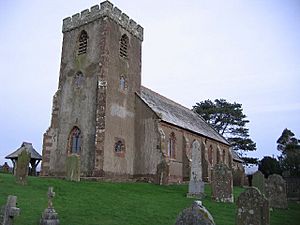St Paul, Irton facts for kids
Quick facts for kids St Paul, Irton |
|
|---|---|

St Paul, Irton
|
|
| Lua error in Module:Location_map at line 420: attempt to index field 'wikibase' (a nil value). | |
| OS grid reference | NY0915900477 |
| Location | St Paul, Irton, Cumbria |
| Country | England |
| Denomination | Anglican |
| Website | [1] |
| History | |
| Status | Parish church |
| Dedication | St Paul |
| Administration | |
| Parish | Irton with Santon |
| Deanery | Calder |
| Archdeaconry | West Cumberland |
| Diocese | Carlisle |
| Province | York |
St Paul, Irton is a historic church located in a beautiful area called Irton with Santon, in Cumbria, England. It's an active Anglican church, which means it's part of the Church of England. This special building is also listed as a Grade II* Listed Building, showing how important and old it is! The church is part of the diocese of Carlisle.
Contents
A Journey Through Time: The History of St Paul's
St Paul's church was first built a very long time ago, in the 13th century, by a group of monks called Augustinian monks. It was later rebuilt and officially opened again in 1865. The new design was created by Miles Thompson from Kendal. He cleverly used the original stone and wood from the old church.
More changes and updates happened in 1887. These were done to celebrate the Golden Jubilee of Queen Victoria, which marked 50 years of her being queen. During these updates, the church got its current timber roof.
Exploring the Architecture of St Paul's
The church is built from local stone and has a special outer coating called pebble dash stucco. Its roof is made of slate tiles with decorative terra-cotta tiles along the top.
Inside, the church has a main open area called a nave with four sections. At the west end, there's a tall tower. There's also a chancel with three sections, which is the part of the church near the altar. Next to it is a small room called a vestry.
Special Features Inside
The tower holds eight bells that can be rung together. These bells were a gift from Sir Thomas Brocklebank, a very important person in the shipping business. His company, Brocklebank Shipping Co, started in Whitehaven. You can find memorials inside the church that remember members of the Brocklebank family and Admiral Lutwidge.
The floor is covered with beautiful patterned tiles called Minton Encaustic tiles. The stone font, used for baptisms, has four marble pillars supporting a round bowl. On the bowl, you can see carvings of symbols representing the Four Evangelists, who wrote the Gospels in the Bible.
The pulpit, where sermons are given, is made of wood and has eight sides. It has open, decorative carvings. The wrought-iron gates in the tower arch have fancy scrollwork. The pipes of the church's organ are decorated with a design called a Fleur-de-lis, which looks like a lily flower. The pews, which are the long wooden benches for people to sit on, are made of dark wood and have a carved shape called a quatrefoil at their ends.
Beautiful Stained Glass Windows
St Paul's Church has many stunning stained glass windows. Two pairs of these windows were designed by the famous artist Sir Edward Burne-Jones and made by William Morris & Co. These windows show images of St Paul, a prophetess called The Tiburtine Sibyl, St Agnes with a lamb, and St Catherine of Alexandria.
The Churchyard and Irton Cross
The churchyard around St Paul's has about 100 gravestones. There's also another cemetery nearby with about 100 more, including one grave for a soldier from the Commonwealth War Grave.
A very important historical object stands in the churchyard: the Irton Cross. This is an Anglo-Saxon cross that dates back to the early 9th century. It's an ancient stone cross with carvings. Experts believe it was made between the times of the Bewcastle Cross and the Gosforth cross. It looks more like the older Anglo-Roman style of the Bewcastle Cross. Pevsner, a famous historian, said this is one of the most important crosses in the area of Cumberland.

